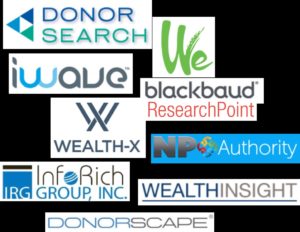Part 2 of 4: Donor Prospecting
 Whether you’re a large development shop or a one-(wo)man show, a healthy prospect pipeline is imperative to your organization’s long-term sustainability.
Whether you’re a large development shop or a one-(wo)man show, a healthy prospect pipeline is imperative to your organization’s long-term sustainability.
Throughout this four-part series, we’re exploring a few tools that can help you identify, qualify and add new prospects to your pipeline and into your gift officers’ portfolios—to help you break out of the rut of relying on the same people for the same major gifts year after year, campaign after campaign.
In our last installment, we reviewed the various pipelines you may have for capturing new prospects. We saw that, for the most part, organizations have multiple ways in which new individuals are added to their databases. The question now becomes:
How do we qualify these individuals so that we can prioritize our limited resources, focusing on those most likely to make donations (and preferably mid-level and leadership gifts)?
Finding Your Best Donor Prospects Through the Magic of Today’s Technology
Schultz & Williams Senior Consultant Pat Voigt and I recently wrapped up a workshop, “Finding Your Best Donor Prospects Through the Magic of Today’s Technology,” at the ADVIS (Association of Delaware Valley Independent Schools) Retreat. So, if you attended this workshop, what I’m about to cover will sound very familiar.
As a starting point, S&W has deemed philanthropic capacity screening (traditionally known as wealth screening before these screening services started factoring in philanthropic inclination) as one of the most effective low-cost methods for qualifying prospects. There are many options on the market today, and ultimately, any of them are better than not screening your records.
 Disclaimer
Disclaimer
- S&W receives no discount or benefits from any vendor…
- Nor do we receive any sort of credit/compensation from any vendor to refer clients.
- Our preferences stem from personal experience with and knowledge of the tools.
- Please choose the tool(s) that work best for your organization.
At S&W, we have the following philosophy: Capacity + Affinity + Philanthropic Inclination = Hot Prospect.
This philosophy has influenced our decision to primarily use DonorSearch when screening records for clients. The following is how we would rank a few of today’s leading options.
Screening Tools (S&W ranked)
- DonorSearch
- Strong match logic (confidence that the person screened is the person in our database)
- Strong donor capacity screening
- Very robust philanthropy screening
- Constant review of the subscription databases the information is pulled from
- WealthEngine & iWave
- Strong capacity screening
- Weak philanthropy screening
- Iffy match logic
- ResearchPoint (Blackbaud Target Analytics)
- Strong match logic (though not as robust as DonorSearch)
- Decent capacity screening
- Weak philanthropy screening
- Word of caution: ResearchPoint will heavily weigh affinity as expressed through giving history in determining ask ranges. (Refer to the case study below.)
Case Study
Let’s look at a case study to highlight the benefits of this tool. Here’s the scenario:
- An independent school, grades 9-12, is about to conduct a campaign planning study to test a goal of $40 million for capital/endowment.
- The school first ran the ResearchPoint screening during their transition to Blackbaud NXT.
- The school knows its alums are extremely loyal and connected, BUT up until last year, no one was asking them for anything more than a token annual gift.
S&W reviewed the original ResearchPoint ratings, with the following findings:
- ResearchPoint factored in affinity, which it measured by giving history.
- The results indicated most alums were not able to make a major gift because affinity trumped capacity and philanthropic inclination.
- Word of caution: When using ResearchPoint, do not provide giving history if you believe it is not an indicator of affinity, like in this scenario.
S&W then ran the full database through DonorSearch… resulting in extraordinary findings:
- 250+ can give $500,000 or more!
- 500+ can give $250,000 or more!
- Based on the asks being made by this organization and the gifts it has received in return, the DonorSearch ratings were right on target.
Key Takeaways
- Screening your constituent database, or a subset of the database, is a critical step in understanding who is in your universe and how to prioritize your prospect work.
- Screen your database every 2-3 years, or at least consider screening new additions to the database if they are considered potential prospects.
- It’s worth the investment—at typically just $0.20/record, philanthropic capacity screening generates an enormous ROI!
- There are many options on the market today. Do your due diligence before selecting a vendor—and be sure not to place too much weight on tool aesthetics.




